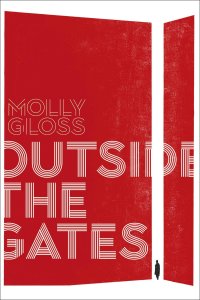Gary K. Wolfe reviews Jonathan Carroll
Jonathan Carroll’s greatest charm as a writer may well be simply that no one has yet been able to pin him down. The blurbs alone on his new novel Bathing the Lion invoke everyone from Philip K. Dick to Kafka, the Brothers Grimm, Michael Chabon, and Garcia Marquez, and while it’s not difficult to find bits here and there that suggest all these writers and more, the full effect of his fiction remains maddeningly elusive. In a key scene in Bathing the Lion, the main characters find themselves sharing a dream in which a giant, bright red elephant named Muba saunters down the road toward them, sporting an oversized wristwatch (how many adult writers would even try to bring that off?), and a mysterious design on his side that may be some sort of map or key to what’s really going on. But each of the characters sees a different map or design, and ascribes a different meaning to it based on their own experiences. They might as well be reading the novel they’re in. As usual, though, Carroll manages to weave his colorful imagery into a surreal tapestry which, if not quite seamless, is immensely appealing in its generosity and good humor.
There has been a good deal of discussion lately, some of it from these quarters, about the permeability of genre boundaries, but Carroll has been playing this game since the beginning of his career, and he remains almost unique in his ability to shift codes not only within a story or novel, but sometimes even from one sentence to the next. Dogs, for example, almost a trademark feature of his fiction, show up here in the form of D Train, a ‘‘cheerful screwball’’ of a pit bull who nevertheless doesn’t take well to obedience training; ‘‘D befriended all the other dogs in his class while never learning to obey even one command.’’ A charming detail of domestic realism, to be sure, but only a sentence later we learn the reason: ‘‘In his last life, the pit bull had been a zgloz on Ater, a smelly, dreadful planet,’’ so that ‘‘in this new life on Earth he was just showing how happy he was to be away from such a miasma of misery.’’ Then Carroll yanks us back into domesticity with an anecdote about how the dog was randomly shot (not fatally, as it turns out) during an evening walk.
Carroll does this sort of thing all the time, and practically no one else does it at all. His novels are cluttered with unexpected exit ramps leading to bizarre byways which, more often than not, reveal what the tale is really about. Bathing the Lion begins with a couple discovering that their marriage is failing; the husband, Dean Corbin, who owns a high-end men’s clothing store in the small Vermont town where they live, is acting out his midlife crisis by buying a high-tech sled, while his wife Vanessa, a singer at a local club, has been having a clandestine affair with Dean’s business partner Kaspar Benn. For the first couple of chapters, we might easily be in an Updike or Cheever story – until we meet a mysterious little girl named Josephine, who has a habit of running across the rooftops of the town. When a photographer takes pictures of her, they come out only as beautifully composed shots of vegetables, and when she speaks to Kaspar, it’s to warn him that ‘‘After today I go away forever,’’ and that ‘‘It’s the last day I can help you.’’ Not long after, she appears to the guilt-ridden widower William Edmonds with similarly cryptic messages about ‘‘these things called mechanics,’’ and not long after that, Vanessa and Dean meet at his clothing store to find that it’s disappeared and been replaced by the magazine shop that had been there decades earlier.
Episodes like these are a key to Carroll’s unique approach to the fantastic, and to what makes his novels so consistently surprising. Rather than introducing a succession of clearly linked clues that lead us deeper into the fantasy world – like, say, a lamppost in a wood – he offers apparently random jigsaw pieces that initially seem to leave the assembly to us. Some of these pieces seem to belong to a finely tuned account of a group of troubled but largely sympathetic characters in a realistic Vermont town, while others may involve cosmic mechanics trying to save the universe from, literally, the forces of Chaos. We learn of blips in reality like ‘‘flips,’’ in which people may be returned to any point in their earlier lives, but with all their later memories intact, or ‘‘somersaults,’’ which seem to involve a sudden and drastic reordering of reality itself. The fantastic isn’t something we enter through a familiar portal, but rather a part of the fabric of daily life – or, more accurately, daily life is part of the fabric of it.
It’s not long before we learn that nearly all these main characters, and others, have, in fact, been those very cosmic mechanics – something they learn in that shared dream in which the red elephant appears (along with a talking black lounge chair) – and that their memories of their lives as reality cops have been erased upon their retirement. But now all the retired mechanics in the universe are being called back to service in the face of a resurgent threat from the agents of Chaos, who have informed one of them that – now that Somersault has arrived – they must choose whether to ‘‘bathe their lion or try to fight it.’’ While this clearly seems to evoke the familiar Secret Masters theme we’ve seen everywhere from Chesterton to Dick, Carroll refrains from turning his characters into symbols once they’ve discovered their true identities. Though they may have worked in other eras or even other galaxies, they remain fully themselves, with Vanessa’s spoiled selfishness, her boss Jane’s joyful love for her partner Felice, Edmond’s lingering anguish over his wife’s death from cancer, even the dog’s abiding good nature. Carroll’s familiar themes of love, regret, memory, and – well – dogs, are as fully realized here as in any of his novels, and even when his wisdom sounds disarmingly simple or even sentimental, he seems to genuinely wish well for his characters and for us. Humans, he points out, are neither quite mechanics nor agents of chaos, but by ‘‘using their imaginations they have the ability to keep order, or create, or cause mayhem and confusion. Most importantly, it’s usually a conscious choice which one we do.’’ It’s something of an achievement that the very structure of this intricate and lovely tale serves to remind us of that.








